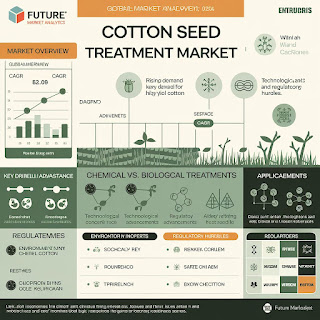The Cotton Seed Treatment Market: Protecting the Foundation of Global Cotton Production
The cotton
seed treatment market represents a critical segment of modern agriculture,
serving as the first line of defense for one of the world's most important
fiber crops. As global cotton production faces mounting pressures from climate
change, evolving pest resistance, and increasing sustainability demands, the
seed treatment industry has emerged as an essential component in ensuring
healthy crop establishment and maximizing yield potential.
Explore the Full Report - https://futuremarketanalytics.com/report/cotton-seed-treatment-market/
Market Dynamics and Growth Trajectory
The cotton seed treatment market has demonstrated robust
growth, with valuations reaching approximately $3.33-3.48 billion in 2024.
Industry projections indicate the market will expand from $3.61 billion in 2025
to $5.02 billion by 2034, reflecting the growing recognition among cotton
producers of seed treatment's value proposition.
North America leads this market expansion, with regional
projections showing growth from $1.10 billion in 2025 to $1.68 billion by 2030.
This growth trajectory underscores the increasing adoption of advanced seed
treatment technologies across major cotton-producing regions.
The Science Behind Cotton Seed Treatment
Cotton seed treatment encompasses a sophisticated array of
chemical and biological protectants designed to shield seeds and emerging
seedlings from multiple threats. The primary categories include fungicides,
insecticides, and nematicides, each targeting specific risk factors that can
devastate cotton stands.
Fungicidal treatments address soil-borne pathogens that
cause seed decay, damping-off, and seedling blight. Modern fungicides like
myclobutanil protect against critical diseases such as sore shin (Rhizoctonia
solani) and black root rot (Thielaviopsis basicola). Azoxystrobin represents
another breakthrough, offering broad-spectrum protection with systemic
properties against numerous seed-borne and soil-borne pathogens.
Insecticidal seed treatments provide early-season protection
against devastating pests like thrips, aphids, and wireworms that can destroy
vulnerable cotton seedlings. These treatments are particularly valuable in
integrated pest management programs, reducing the need for foliar applications
during critical establishment periods.
Nematicide components target microscopic roundworms that can
severely impact cotton root systems. Traditional nematicides like aldicarb have
shown dramatic yield increases when controlling root-knot nematodes, though
newer formulations focus on more environmentally sustainable approaches.
Technological Innovation and Market Evolution
The cotton seed treatment landscape is experiencing rapid
technological advancement. Biological seed treatments, particularly
microbial-based solutions, captured 65.2% of the biological segment in 2024,
reflecting growing interest in sustainable, environmentally friendly protection
strategies.
Major industry players including Corteva Agriscience,
Syngenta AG, Bayer Crop Science AG, and UPL Limited are investing heavily in
research and development, creating more targeted, efficient formulations that
provide comprehensive protection while minimizing environmental impact.
Market Drivers and Future Outlook
Several factors drive the cotton seed treatment market's
expansion. Climate variability has increased disease and pest pressure, making
protective treatments more critical than ever. Additionally, the rising cost of
cotton seeds incentivizes growers to maximize germination rates and stand
establishment through comprehensive treatment programs.
The push toward sustainable agriculture practices has also
catalyzed innovation in biological treatments and reduced-risk chemistries.
Consumer preference for organic and sustainably sourced products is creating
competitive advantages for companies developing environmentally conscious
solutions.
The cotton seed treatment market stands at an inflection
point, balancing traditional efficacy with emerging sustainability
requirements. As cotton production systems become increasingly sophisticated,
seed treatments will likely evolve into more precisely targeted,
environmentally integrated solutions that support both productivity and
ecological stewardship. This evolution positions the market for continued
robust growth while addressing the complex challenges facing modern cotton
agriculture.




Comments
Post a Comment